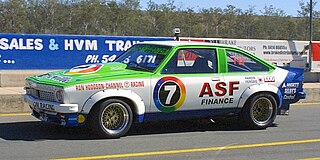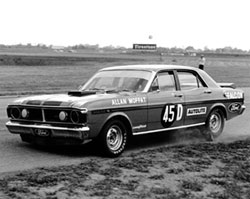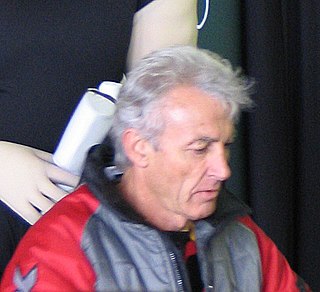
Peter Geoffrey Brock, otherwise known as "Peter Perfect", "The King of the Mountain", or simply "Brocky", was one of Australia's best-known and most successful motor racing drivers. Brock was most often associated with Holden for almost 40 years, although he raced vehicles of other manufacturers including BMW, Ford, Volvo, Porsche and Peugeot. He won the Bathurst 1000 endurance race nine times, the Sandown 500 touring car race nine times, the Australian Touring Car Championship three times, the Bathurst 24 Hour once and was inducted into the V8 Supercars Hall of Fame in 2001. Brock's business activities included the Holden Dealer Team (HDT) that produced Brock's racing machines as well as a number of modified high-performance road versions of his racing cars.

The Bathurst 1000 is a 1,000-kilometre (620 mi) touring car race held annually on the Mount Panorama Circuit in Bathurst, New South Wales, Australia. It is currently run as a championship event for Supercars.
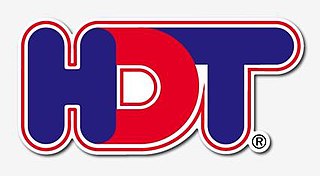
The Holden Dealer Team (HDT) was Holden's semi-official racing team from 1969 until 1986, primarily contesting Australian Touring Car events but also rallying, rallycross and sports sedans during the 1970s. From 1980 the Holden Dealer Team, by then under the ownership of Peter Brock, diversified into producing modified road-going Commodores and other Holden cars for selected dealers via HDT Special Vehicles.

Colin John Bond is a retired Australian racing driver. Bond reached the highest levels in Australian motorsport in 1969 when he was recruited by Harry Firth to the newly formed Holden Dealer Team. He quickly found success, winning the 1969 Hardie-Ferodo 500 mile race at Bathurst, New South Wales in a Holden Monaro.
John GossOAM is an Australian retired motor racing driver who competed in his home country during the 1960s, 1970's and 1980's. He is the only driver to have won Australia's two most prestigious races, the Bathurst 1000, and the Australian Grand Prix (1976).
Allan Maxwell Grice, known to motor-racing fans as "Gricey", is an Australian former racing driver and politician, most famous for twice winning the prestigious Bathurst 1000, and as a privateer driver of a Holden in the Australian Touring Car Championship.
The 1998 AMP Bathurst 1000 was the 39th running of the Bathurst 1000 touring car race. It was held on 4 October 1998 at the Mount Panorama Circuit just outside Bathurst. It was the second year of the controversial split between race organisers, the Australian Racing Drivers Club, and V8 Supercar, which had led to Australia's leading touring car series leaving the Bathurst 1000. The V8 Supercar teams raced the 1998 FAI 1000 race, held six weeks later. The race distance was 161 laps, approximately 1000 km.
The 1960 Armstrong 500 was an endurance motor race for Australian made or assembled standard production sedans. The event was held at the Phillip Island Grand Prix Circuit in Victoria on 20 November 1960 over a distance of 167 laps x 3.0 miles = 501 miles.
The 1994 Tooheys 1000 was a motor race held on 2 October 1994 at the Mount Panorama Circuit near Bathurst in New South Wales, Australia. It was the 35th running of the Bathurst 1000 touring car race. The race was open to cars complying with CAMS Group 3A Touring Car regulations, later known as V8 Supercars and those complying with FIA Class II Touring Car regulations, later known as Super Touring cars. In the lead up to the 2003 event, Wheels Magazine voted the 1994 Bathurst 1000 to be the greatest of all time.
Robert Morris is an Australian former racing driver. Morris was one of the leading touring car drivers during the 1970s and continued racing until 1984. Morris won Australia's premier Touring car race, the Bathurst 1000 in 1976. He also won the Australian Touring Car Championship in 1979. Morris was inducted into the V8 Supercars Hall of Fame in 2004.
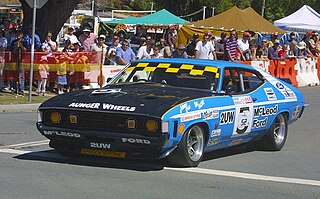
The 1974 Hardie-Ferodo 1000 was an endurance race for Group C Touring Cars, held at the Mount Panorama Circuit near Bathurst in New South Wales, Australia on 6 October 1974. The race was Round 3 of the 1974 Australian Manufacturers' Championship and was the 15th in a sequence of annual “Bathurst 1000” races commencing with the 1960 Armstrong 500.
The 1984 Australian GT Championship was a CAMS sanctioned national motor racing title and was the seventh Australian GT Championship to be awarded. It was a series open to grand tourer cars complying with CAMS Group D regulations with Group B Sports Sedans competing by invitation. The series was contested over six rounds from 15 April to 9 September 1984.
John Francis Harvey is a retired Australian racing driver. He was a top Speedcar driver for many years in the 1950s and 1960s, winning many championship races including the NSW Championship for three successive years and the Victorian Championship twice before turning his skills to road racing where he had a long and successful career until his retirement at the end of 1988.
The 1961 Armstrong 500 was an endurance motor race for standard production sedans. The event was held at the Phillip Island circuit in Victoria, Australia on 19 November 1961 over 167 laps of the 3.0 mile circuit, a total of 501 miles (807 km). The race was organised by the Light Car Club of Australia and was sponsored by Armstrong York Engineering Pty Ltd.
The 1968 Hardie-Ferodo 500 was a production car race held on 6 October 1968 at the Mount Panorama Circuit just outside Bathurst in New South Wales, Australia. It was the ninth running of the Bathurst 500.
The 1963 Armstrong 500 was the fourth running of the Armstrong 500 touring car race. It was held on 6 October 1963. After the 1962 race, the Phillip Island Grand Prix Circuit was too damaged to continue to stage the race, forcing it to move to a new location, the Mount Panorama Circuit just outside Bathurst with a new organising club, the Australian Racing Drivers Club. The race was open to standard production sedans with four classes based on the purchase price of the vehicle.
The 1965 Australian Touring Car Championship was a CAMS sanctioned motor racing title open to Group C Improved Production Touring Cars. It was contested over a single 40-lap race staged at Sandown Raceway in Melbourne, Victoria, Australia on 11 April 1965. It was the sixth Australian Touring Car Championship title to be awarded and the first to be contested by cars complying with Group C regulations.
The 1963 Australian Touring Car Championship was a CAMS sanctioned motor racing title for drivers of Appendix J Touring Cars. It was contested over a single 25 lap, 50 mile (80 km) race at the Mallala Race Circuit in South Australia on 15 April 1963 and was the fourth running of the Australian Touring Car Championship. The race was won by Bob Jane, driving a Jaguar Mark 2 4.1.
The 1968 Australian Touring Car Championship was a CAMS sanctioned Australian motor racing title open to Group C Improved Production Touring Cars. It was contested over a single race staged at the Warwick Farm circuit in New South Wales, Australia on 8 September 1968. The title, which was the ninth Australian Touring Car Championship, was won by Ian Geoghegan driving a Ford Mustang. It was the final Australian Touring Car Championship held as a single race, with the title being contested over a series of races from 1969 onwards.
Robin John "Bob" Holden is an Australian racing driver. Holden raced small-engined touring cars throughout his career, racing Peugeots in the early 1960s, establishing a reputation for himself which saw him become a regular part of BMC Australia racing program for Minis which culminated with a victory in the 1966 Bathurst 500 co-driving with Rauno Aaltonen. Into the 1970s Holden moved on to race Ford Escorts in various guises, moving into Toyota Corollas in the 1980s, winning the 1.6 litre class at the Bathurst round of the 1987 World Touring Car Championship. In the mid-1990s Holden moved into BMW M3s and later a BMW 318i Super Touring car in which he raced his final Bathurst in 1998, at the time setting the record for most Bathurst appearances.


